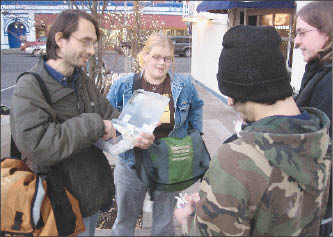Minneapolis—When outreach worker Amanda Danielson sets out to connect with homeless and runaway youth, she does not walk into the supply room at her nonprofit’s downtown office building to fill a backpack with such items as toothpaste, condoms and socks – a routine among many of the nation’s outreach workers. Instead, she turns to her keyboard and goes to MySpace.
Even street kids socialize on MySpace, making the site a regular stop for staffers at Freeport West, whose StreetWorks Collaborative program has spent 13 years forging a reputation for cutting-edge work with homeless and runaway youth. StreetWorks’ outreach efforts reach a reported 30,000 youth a year, and its manager, Trudee Able-Peterson, literally co-wrote the book about street outreach: StreetWorks: Best Practices and Standards in Outreach Methodology to Homeless Youth.
 |
|
Able-Peterson: StreetWorks’ suburban strategy “takes a lot of gas and creativity.” |
So it’s worth a visit to see how StreetWorks is trying new approaches and creating new alliances in response to changes in behavior patterns among local homeless youth – changes that are showing up, in varying degrees, in communities around the country. Those changes can be summed up largely as migrations: to the suburbs; to underground locales, especially among immigrants; and, for youth prostitutes, off the streets and onto the Internet.
“We’re trying to catch up to all of the new challenges,” Able-Peterson says.
Moving Out
For as long as anyone can remember, outreach workers have built relationships with youth by filling a backpack with personal care supplies and literature about community services, and walking along the areas where street kids and runaways congregate, such as parks, waterfronts and business districts. The 20 outreach workers at StreetWorks, including Danielson, still do that.
More and more, however, that tried-and-true method misses people. On any given night, more than half of Minnesota’s 1,300 homeless youth (age 21 and under) are in “greater” metropolitan areas, according to Overview of Homelessness in Minnesota 2006, by Wilder Research.
That’s because in Minneapolis and other cities, urban gentrification is pushing kids out of traditional street locales. “As upper-income professionals move back into the cities, lower-income households are relocating to first- and second-tier suburbs,” says Richard Hooks Wayman, senior policy analyst with the National Alliance to End Homelessness and co-author of “Streetworks.”
Organizations that serve the homeless in such locales as rural New Jersey and the suburbs of Portland, Ore., and Washington are trying to deal with the migration to the suburbs. In Portland, the movement stems from a city effort to rid downtown of homeless people and from the city’s light rail system, which makes it easy for teens to commute to and from suburban camps, says Dennis Lundberg, program supervisor for Janus Youth Programs’ well-known Yellow Brick Road initiative.
In Washington, the multi-service Latin American Youth Center set up a second location in the Maryland suburbs to help serve Latinos moving out of the city. But shelters and services for homeless youth are few and far between, says Laura Bowman Pimental, program coordinator.
“We don’t have the resources to take outreach that far,” she says.
The situation is similar in Minneapolis, where StreetWorks outreach worker Larry Nelson observes, “We’ve found a real need in the suburban communities, and local services aren’t catching up to kids’ needs yet.”
 |
|
Nelson: “We’ve found a real need in the suburban communities.” |
Shelter and housing services met only 15 percent of the need in Minnesota in 2005, according to “Report to the Legislature: Runaway and Homeless Youth in Minnesota,” released this year by the state Department of Health and Human Services.
Only one organization, YMCA Point Northwest, provides shelter services for the 15 Minneapolis suburbs extending 30 miles from downtown. Many homeless youth in the suburbs couch-hop from one friend’s home to another or sleep where they work.
The new homeless phenomenon is especially apparent in Plymouth, a suburb of about 70,000 about 15 miles from downtown. Police dub one local trailer park “Little Mogadishu,” because of its large East African population. StreetWorks staffers began working the area early this year, playing basketball with kids and networking with school-based social workers.
The agency’s outreach workers have traveled northwest of Minneapolis to Rogers and south of St. Paul to Dakota County, setting up satellite offices at recreation centers and YMCAs, taking soda and snacks to skate parks and staffing information tables at movie theaters.
The suburban strategy is just a few years old, and StreetWorks is striving to define a methodology. “It takes a lot of gas and creativity,” Able-Peterson says.
New Partnerships
Another new strategy for tackling the problem involves the StreetWorks collaboration, whose 10 member agencies include The Bridge for Runaway Youth, an emergency shelter and transitional living program; District 202, a social, educational and cultural space for gay and transgender youth; and Southeast Asian Community Council, an agency dedicated to meeting cultural needs specific to southeast Asians.
By pooling resources, the agencies blanket the city and suburbs seven days a week with two to six teams of outreach workers.
Nelson says the suburban outreach workers are more likely to field calls from community agencies than from youth looking for services. So the team does a fair share of marketing to agencies as well as to kids, educating organizational staff about services (even those that exist only in the city) and advocating for programs in the suburbs.
The problem is severe enough for local advocates to have created a West Metro Homeless Task Force, and Heading Home Hennepin – a plan by government, businesses and community groups to end homelessness in Hennepin County by 2016 – includes adding 30 youth shelter beds in the suburbs.
Undocumented and Underground
Immigrant youth face new challenges in the Twin Cities and across the nation. With the national spotlight on illegal immigration, undocumented Hispanic youth are trying to stay invisible.
“Rather than trying to access services, they’re living 10 to 12 in an apartment,” says Jose Acuna, an outreach worker with Project Offstreets, a Minneapolis drop-in center and a member of the StreetWorks Collaborative.
One strategy for connecting with undocumented youth is word of mouth, and this is where the time-tested outreach tools that win community trust continue to pay dividends. Outreach workers play basketball with 10- and 12-year-old Somali kids, aiming to connect with older siblings who may be homeless and also to forge connections with at-risk youth.
Other immigrant populations require a different approach. The Twin Cities metropolitan area has captured the unofficial title of Hmong capital of the United States, with about 60,000 Hmong. StreetWork’s Hmong outreach team is an offshoot of another collaborative member: the Southeast Asian Community Council. The team often works through Hmong funeral homes. During the three- to four-day funerals, everyone in a Hmong clan is accepted and welcomed to feast with the community, making them ideal for street youth to visit and rest.
In addition, StreetWorks has hired Latino and Somali outreach workers to broaden its diversity and help meet the culturally specific needs of locals.
In Washington, Pimental of the Latin American Youth Center says its reputation has allowed it to maintain connections with local youth, despite the crackdown on illegal immigrants in the Washington area. The center forged a partnership with Ayuda, a legal organization that helps youth attain work permits and make the transition toward legal residency. And it asks undocumented youth who have graduated from college to share their stories with young Latinos to offer a sense of possibility and hope.
High-Tech Challenges
 |
|
Reaching Out: Neal Sand and Jasmine Pettet of Janus Youth Programs connect with homeless youth in Portland. |
When it comes to serving homeless and runaway youth, technology is a double-edge sword.
On one hand, it makes it harder to find some youth, such as sex workers.
“Prostitution has all but disappeared on the streets,” Able-Peterson says. That’s because pimps, prostitutes and johns now routinely connect online at sites like Craigslist, and through cell phones.
At the same time, the computer is a draw for homeless youth. When they check into drop-in centers, many youths ask for access to a computer before a shower. The youths connect not only with friends through e-mail, but with family as well – which can be beneficial in the long run by easing rifts and even facilitating reunification.
Like other outreach organizations, StreetWorks saw the importance of joining the online community and launched its MySpace page in July 2006. The page tells visitors about organizations in the StreetWorks Collaborative, and provides a way for youth to connect with outreach workers via e-mail. The page is maintained by a part-time contractor, who also visits chat rooms.
At Yellow Brick Road in Portland, Lundberg blogs and maintains a MySpace page. He says youth use the page to maintain contact with him and other outreach workers.
Nevertheless, MySpace is just a start. “We’d like an interactive Web page where an outreach worker could answer questions from kids,” Able-Peterson says. That would require more money.



























